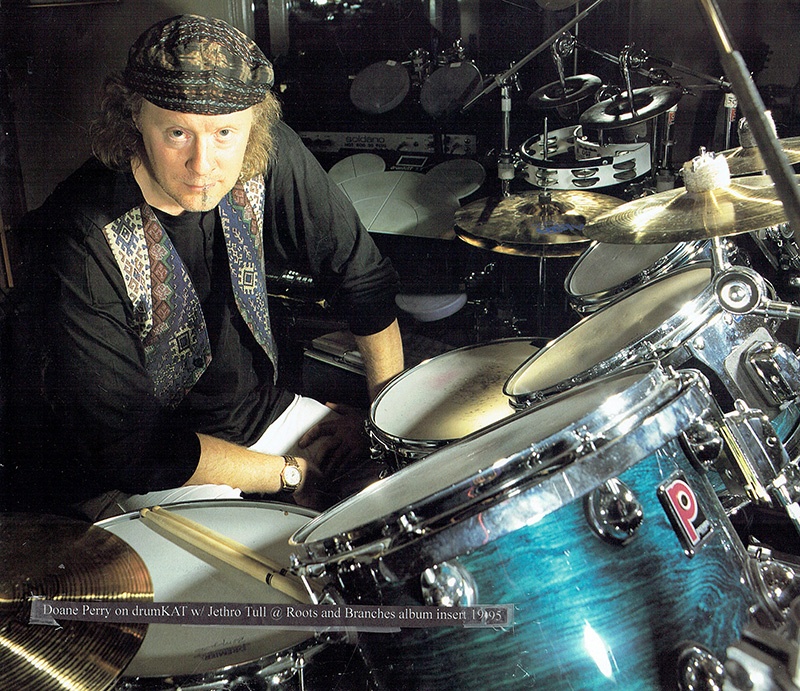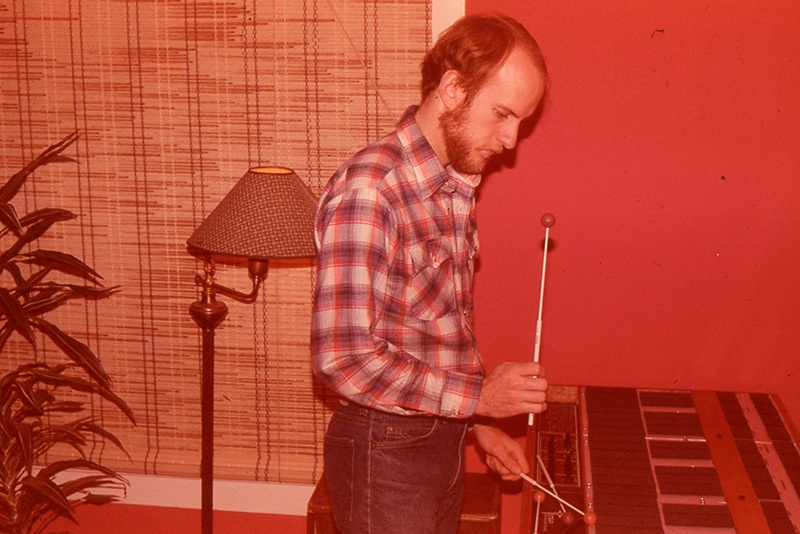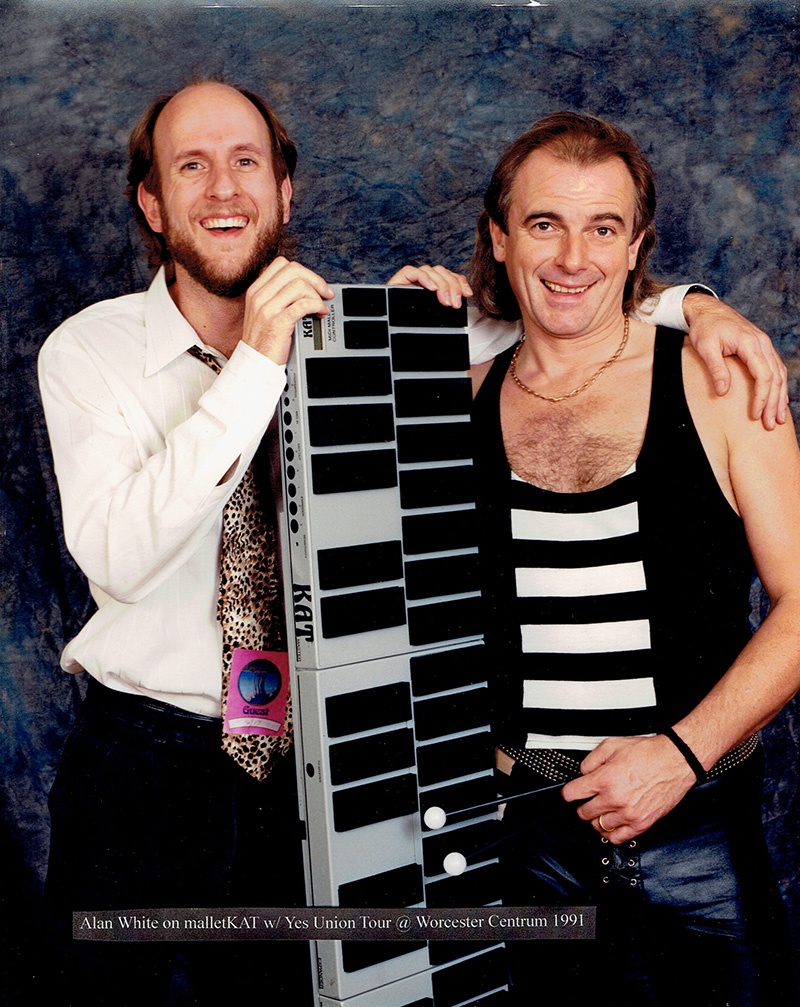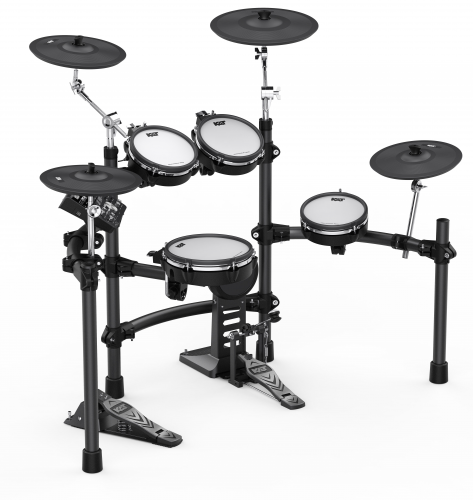By Nicolas Grizzle
The Pioneering History of E-Drum and MIDI Percussion Pioneers KAT, Inc.
Though it may not be a household name like some other brands, the electronic percussion world owes a debt of gratitude to the scrappy, independent minds at KAT for pushing the boundaries of MIDI percussion instruments, starting in the mid 1980’s and continuing through today.
KAT’s bread and butter is creating new instruments and innovating existing designs to have more capability and playability than what’s currently available. Starting with its very first products, the innovations coming from this young, upstart company from Massachusetts were forcing the bigger companies to push their own R&D further, much to the benefit of drummers everywhere.
KAT entered the electronic percussion world with a major splash when it released the malletKAT, a MIDI-based mallet percussion controller, in 1986. “Out of nowhere we were up there with Yamaha and Roland,” says Mario DeCiutiis, who was the company’s sales director at the time. “Our product was better than theirs. We caught them by surprise.”

DeCiutiis met KAT founder Bill Katoski in 1984 after reading a magazine article about his work on building an electronic mallet percussion instrument. DeCiutiis was (and still is) a professional orchestral percussionist, and he was intrigued by the potential of this idea. He quickly came on board as the company’s salesman and convinced Katoski to redesign the instrument to take advantage of the recently standardized MIDI technology.
The malletKAT was such a solid design that it was the only widely available instrument of its kind on the market for 30 years and remains a popular choice for professional percussionists. Today, many scores even have parts specifically written for the malletKAT (it often appears notated for “KAT” in the score), including for Radio City Music Hall, where DeCiutiis has played for the past 40 years.
KAT products are known for their durability and upgradability, and for being designed with players in mind above all else. “My goal is to make the best instrument, not caring if I sell a million of them, but establishing it as the most musical controller out there,” says DeCiutiis.

KAT is still going strong, designing new instruments and adding upgrades to tried-and-true designs. You may recognize some of their incredibly sensitive and responsive instruments like the malletKAT, drumKAT, jamKAT, and trapKAT (sensing a naming pattern yet?). They’re also well known amongst electronic and hybrid drumming enthusiasts for their hybrid drumheads the In-Head and On-Head and electronic drum modules and adaptors like the DITI (Drum Intelligent Trigger Interface) and FTB (FSR Trigger Box).
In 2013 KAT entered into a licensing deal with KMC Music (a subsidiary of Fender Music) to create a line of beginner and intermediate products under the KAT Percussion name and compete in the electronic drum market. In 2015 the license was transferred to DW Drums and then to Hal Leonard in 2017, where it remains today. While Alternate Mode continues to innovate and introduce new products, the KAT brand is focused on broadening the appeal and availability to more drummers with traditional drum set configurations for drummers at different stages of their musical career.
After his initial success as a sales director, DeCiutiis later became a vice-president of the company and today, nearly 40 years later, is the owner. What made it such a good fit from the outset, says DeCiutiis, is that he was a pro player who knew what was important to working professionals and Katoski was a brilliant engineer who could design and build just about any instrument DeCiutiis dreamed up. Together, they developed some game-changing and long-lasting electronic percussion instruments.
Here’s a timeline of KAT’s major moments, including releases of key innovative products and their impact on the musical world.


1984: KAT, Inc. is Founded
Bill Katoski had designed an electronic mallet percussion instrument called the Synare MP in 1981 for a company called Star Instruments and bought the rights to it when that company went out of business shortly thereafter. He began working on an updated version with his wife Maria and soon brought on professional orchestral percussionist Mario Deciutiis to form KAT, Inc. Their first instrument was a professional level mallet instrument with eight-note polyphonic synthesis and 16 sequencer banks, as well as on-board sounds that were as good if not better than similar instruments on the market at the time.
1986: malletKAT
With more and more products taking advantage of the new MIDI standardization, KAT saw the writing on the wall early and took to the drawing board to redesign the Synare MP. While Katoski knew that MIDI was the way to go, his early attempts at making this new instrument had failed. Undeterred, he brought a nonfunctional shell of the instrument to NAMM in January 1986 and was surprised at the high amount of interest. It turns out that at that same show was another company demonstrating a component that would unlock the potential of KAToski’s design—the force-sensing resistor (FSR).
The problems that existed in the original KAT MIDI Percussion Controller could be traced back to the piezo sensors used in the original design to trigger the player’s hits to the computer, which would generate the desired sounds. The new FSR sensors were much more sensitive and responsive to dynamics, and soon after NAMM the first working KAT MIDI Percussion Controller was in production. (The name was soon changed to malletKAT.)
Simmons, a giant in electronic percussion at the time, soon released a competing product called the Silicon Mallet and used its large advertising budget to open the world’s eyes to the idea of MIDI percussion controllers. The Silicon Mallet fizzled out, but the public now had an appetite for this type of product and KAT was happy to fill the need.
The FSR sensor that really set this instrument apart is still part of KAT’s DNA today, and it is used in all their top-tier instruments. Most other electronic percussion instruments on the market today continue to be designed with the less expensive but less-sensitive piezo pickups, but the FSR sensor remains a hallmark of KAT instruments.
1988: drumKAT
The drumKAT was the company’s first foray beyond the mallet percussion world. This was KAT’s upgraded answer to the Octapad, which had been released a couple years prior and was being touted as an add-on to a drum or percussion setup. The drumKAT took the idea and, in true KAT fashion, made a few choice upgrades. When it was released, the drumKAT was the only product of its kind using the more advanced FSR sensors and had 10 programmable zones with inputs for 9 more trigger units on top of that, making it the most powerful and versatile MIDI multipad the time. The rectangular unit is immediately recognizable by its playing surface reminiscent of “mouse ears.” An updated version, the drumKAT Turbo, was released in 1998. It has since been updated again and is now sold as the drumKAT Hybrikit.

1996: Reboot as Alternate Mode
In 1995, KAT, Inc. went out of business and Bill Katoski left the company. Mario DeCiutiis bought the company and rebranded it as Alternate Mode. Originally, DeCiutiis says he planned to be a repair shop to service KAT products already in the field. But the itch for innovation was too strong and demand for new products from the company was still out there, and it wasn’t long before Alternate Mode began releasing updated versions of existing KAT products and introducing new instruments.
2010: Drum Intelligent Trigger Interface (DITI)
The introduction of the DITI is another example of how KAT (under the Alternate Mode name) was ahead of its time. The DITI is a trigger-to-MIDI interface that allows users to combine the FSR-based KAT products with any other type of trigger into one drum module. This was a revolutionary step because FSR triggers require external power, and prior to this it was not possible to combine FSR triggers and other triggers into one setup with one streamlined unit. The DITI acted as a hub, sorting out all the different types of electronic data with preset kit types.
Updated versions included a library of 50 preset kit configurations from many different manufacturers. It also has the option to connect via MIDI or USB to a computer’s sound library, or connect to another drum module to use its sounds and configurations.
Older electronic drum kits can get a new lease on life when the DITI is used in place of their own brain, and the creative power of a low-cost, entry-level electronic drum kit is vastly expanded when paired with the DITI. Plus, it can be used as the brain of a system with other triggers, allowing users to design and build their own e-kit, or mix and match their favorite e-drum components, including acoustic drums with any type of trigger.
2013: New Licensing Deal and Expansion of Available Instruments
Recognizing the need for expansion, Alternate Mode licensed the KAT name to expand distribution and start adding in entry- and mid-level instruments from overseas to the product line. This resulted in the KT series of electronic drum sets whith has enabled KAT instruments to be available in a wider range of homes for professionals, hobbyists and students alike. Alternate Mode continues to innovate and produce products under its own brand name, as well the KAT Percussion name, for professional players.
2018: Hybrid Drumhead Technology
KAT, innovating as Alternate Mode, saw the trend toward hybrid drum sets early on and developed one drumhead to handle both acoustic and electronic needs. The Hybrihead was developed with Aquarian (and co-released by Aquarian as the In-Head) to be quality sounding acoustic head that went above and beyond the current standard sensitivity of electronic triggers thanks to the implementation of FSR sensors. A quiet pad version to be placed atop a standard drumhead was also released (known as the Hybripad and On-Head).
Played acoustically, it’s impossible to tell it is a hybrid drumhead. Plugging it in via a nondescript 1/4″ jack enables the head to trigger the any sound in your sample library. This makes it easy to blend miked acoustic drums with electronic samples, or switch between the two with the push of a button.
2021: New E-Drum Sets
For the first time in five years, KAT released updated electronic drum sets including the KT-100, the KT-200 and the KT-300. The updates include a new color scheme (everyone’s favorite: black), as well as larger, mesh heads on the KT-300.

Find out more at KATPercussion.com
